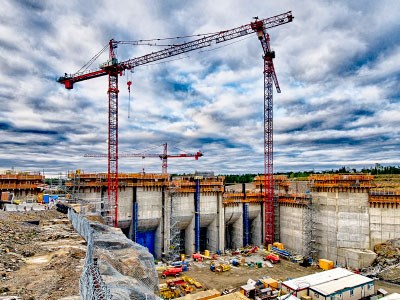Just how big was Ontario Power Generation’s (OPG’s) Lower Mattagami River hydroelectric project?
First, it’s worth mentioning that this was the largest hydroelectric project in Northern Ontario in 50 years, adding or replacing six new generating units on the Mattagami River at a cost of $2.6 billion. At peak construction, about 1,600 people worked onsite, many of whom lived in a large camp (or, perhaps more accurately, a mini-city) made of hundreds of all-season bush tents. These housed the living quarters for the workers, including bedrooms, kitchens, gym, and recreation facilities to help pass the time after shifts.
The project removed 1.35 million cubic metres of rock and overburden, which is enough to just about fill the Rogers Centre (Skydome) in Toronto. When completed, the project almost doubled output between all four stations from 486 MW of electricity to 924 MW — enough to power 438,000 more homes.
And, of course, that’s all green energy.
“This was a good project, and one we’re very proud of,” said Neal Kelly, media director for OPG. “This project created clean, renewable power for the province of Ontario, and will continue to do that for decades and decades to come.”
The project added one new generator each to three existing generating stations along the Mattagami River — Little Long, Harmon, and Kipling — and a complete rebuild of the Smoky Falls Generating Station with three new generators.
The four stations are located close to one another along the Mattagami River about 70 kilometres north of Kapuskasing and 150 kilometres south of Moosonee.
Another key element of the project is that it was completed without adding any new dams to the river. That’s important because it helps preserve the surrounding environment, the traditional lands of area First Nations.
“You’re taking the same footprint, more or less, and building new stations on it,” said Bill McKinlay, OPG’s director of corporate relations. “You’re not required to flood any new lands, so you’re not taking any lands out of services from other uses (such as hunting and trapping).”
Despite the remote location and sometimes difficult working conditions — if the cold wasn’t biting, the bugs were — the five-year project went smoothly.
“We completed the project on budget and ahead of schedule,” Kelly said. It provided about $1 billion in contracts to Ontario companies, including $350 million in the northeast, he said.
Moose Cree First Nation in particular benefitted from the project.
Not only did many community members get training that will be useful in other projects as the region develops, nine were able to complete apprenticeships over the course of the project.
“It’s a significant achievement to complete your entire apprenticeship while working on one project,” Kelly said. Overall, there were about 70 apprentices training on site, including carpenters, chefs, heavy equipment operators, and trades. “They’ll be able to take those skills to other projects.”
Moose Cree benefitted in another major way as well. With a 25 per cent stake in the project, they will receive a quarter of the income from the hydroelectric generated.
“It provides a lasting benefit to the Moose Cree members as well as the OPG,” Kelly said. “This was a unique partnership. This is one of the templates for how OPG does business in terms of building new capacity around the province.”
One other project with a similar partnership arrangement is already underway in northeastern Ontario, due east of the Lower Mattagami Project.
The Peter Sutherland Sr. Generating Station is a 28 MW hydroelectric plant which broke ground in August 2015.
OPG has partnered with Coral Rapids Power, a company wholly owned by the Taykwa Tagamou Nation, a Cree nation on the Abitibi and Little Abitibi rivers.
The $300-million project, expected to be completed by 2018, will create over 200 jobs at its peak, and likely several apprenticeship opportunities as well.
In northwestern Ontario, Lac Seul First Nation and OPG will celebrate seven years of a similar agreement next February.
“We’ve recognized that to move forward with new (generating projects), you have to work with the First Nations. We will continue to pursue partnership models in years to come. It’s a win-win for everyone,” Kelly said.




